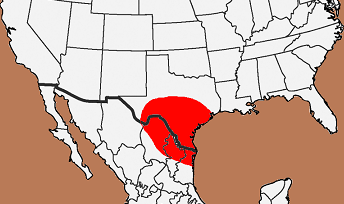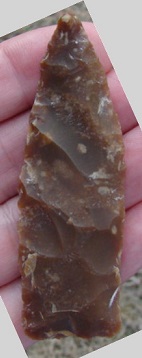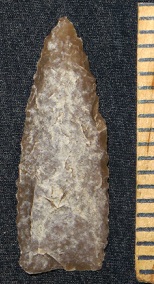Other Websites with Detailed Information:
Name Details:
Named By: Dee Ann Shum, Alex D. Krieger and Edward B Jelks
Named For:
Date Identified: 1954
Type Site:
Pandora
AKA: Wheeler Leaf
Cluster:
Commonly Utilized Material:
Date:
Cultural Period:
3,500 - 2,000 B.P.
Late to Transitional Archaic
Neoglacial to Roman Warm
Glacial Period:
Culture:
Outline is Representative of Size and Shape:
Description of Physical Characteristics and Flaking Pattern:
This is a medium to large
lanceolate point with a flattened to elliptical cross section. The blade is excurvate. The overall appearance may vary
from excurvate to the tip and parallel sides to having excurvate sides, or having a triangular appearance. The base is primarily straight.
Basal thinning is commonly present, but basal smoothing is rarely seen. This point has a random flaking pattern.
Size Measurements: Total Length -
45 to 120 mm, Width - 15 to 30 mm
Distribution:
Distribution Comments:
This point is primarily found from the lower Pecos region
into central Texas, northern Coahuila, northern Nuevo Leon, northern
Tamaulipas, and into the coastal regions. Heaviest concentrations
on the coastal regions of Texas and Mexico.

Additional Comments:
This point is similar to the Kinney point which
has a concave base and the Refugio which has a convex base.
A similar point, the Wheeler
Leaf, was described by Crook and Harris (1954). The Wheeler Leaf
a diagnostic point of the Carrollton Focus as is the Pandora point.
The two may represent the same type. However, as noted by Suhm and
Krieger (1954) the Pandora point seems to be a combination of smaller
narrower points (like the Wheeler Leaf) which they refer to as projectile
points, and larger wider points they feel are knifes. It could be that
the smaller points are Wheeler Leaf points as described by Crook and Harris
while the large knives are Pandora as described by Suhm and Krieger.
Other points in this Cluster:
Point Validity: Valid Type
Suhm was an eminent Texas
anthropologist who, among many distinguished positions, served as Director of Texas Archeological Research Laboratory. Krieger was a renowned anthropologist who spent most
of his career in Texas cataloging projectile points and pottery in Texas before moving on to the University of Washington. Jelks was a distinguished anthropologist and
helped organize the newly formed Department of Anthropology at Illinois State University where he was a Professor. His work in Texas furthered the understanding of Texas
archeology and was a founding force for the Society of Historical Archeology. This type was named in a professional publication and subsequent book and has many
professional references. This is a valid type.
.
Age Details:
This is part of the Edwards Plateau Aspect and the Carrollton Focus.
References: (See Reference Page, Entry Number):
8,
23, 30, 178
Pandora Projectile Point, Pandora Arrowhead





